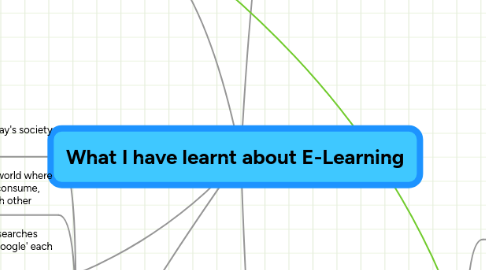
1. Programs
1.1. Scratch
1.2. Goanimate
1.3. CoverItLive
1.4. Mindmeister
1.5. Artpad
1.6. Pageflakes
1.7. Wetpaint
1.8. imovie
1.9. Garage Band
1.10. Audacity
1.11. The Shell Party
1.12. Inspiration / Kidspiration
1.13. Animoto
1.14. Glogster
1.15. Vuvox
1.16. Digied
1.17. Toondo
1.18. Imaginationcubed
1.19. Photostory
1.20. LAMS
2. Understanding Constructionism
2.1. What is it?
2.1.1. Han and Bhattacharya (2001) state that constructionism is ‘both a theory of learning and a strategy for education’ and asserts that knowledge is not simply transmitted from teacher to student, but actively constructed in the mind of the learner. Learners don’t get ideas; they create ideas. Moreover, constructionism suggests that new ideas are most likely to be created when learners are actively engaged in building some type of external artefact that they can reflect upon and share with other.
2.2. Difference between Constructionism and Constructivism
2.2.1. Papert (1993, p. 3) differentiated between constructivism and constructionism: “The word with the v expresses the theory that knowledge is built by the learner, not supplied by the teacher. The word with the n expresses the further idea that happens especially felicitously when the learner is engaged in the construction of something external or at least sharable”.
2.3. How to achieve knowledge through Constructionism
2.3.1. 1. Choose a topic 2. Describe audience 3. Create artefact 4. Pilot artefact (test) 5. Gain feedback 6. Reflect 7. Modify artefact (Han & Bhattacharya, 2001)
2.4. Benefits
2.4.1. Constructionism allows participants to reflect on their learning and what they are taking away from the instruction. This reflection process is helpful for both the facilitator and the participants, as constructionism is geared to prepare learners with skills that will make them life-long learners.
2.5. More information
2.5.1. Constructionism supports the constructivist viewpoint–that the learner is an active builder of knowledge. However, it emphasizes the particular constructions of external artefacts that are shared by learners. Although learners can construct and present knowledge or meanings without producing external products, the processes of construction are more evident when learners produce through social interaction with others and share representations of their understanding and thoughts (Han & Bhattacharya, 2001).
3. Notes on the video Pay Attention
3.1. Our students in today's society are digital learners
3.2. Students were born into a digital world where they expect to be able to create, consume, remix, and share material with each other
3.3. Over 2.7 billion searches performed on 'google' each month
3.4. www = whatever, whenever, and wherever
3.5. ipod + podcast = anytime learning
3.6. Today's children and teens spend 2.75 hours a week using home computers
3.7. People use computers for "richness"
3.8. "It's not attention deficit, I'm just not listening"
3.9. On average, students get to ask a question only once every 10 hours
3.10. Why not use the technology that students love to create/reach/engage/teach more effectively?
3.11. When you lose your mobile you lose part of your brain.
3.12. Mbile phones have become and interestingly enabling tool. Invented to connect us all together, it has become something much more
3.13. There are nearly 90,000,000 ipods out there - why not use them to teach?
4. Interactive White Boards (IWBs)
4.1. Classroom Uses
4.1.1. Lesson Activities
4.1.1.1. All KLAs
4.1.2. Classroom Organisation
4.1.2.1. News Groups
4.1.2.2. Reading groups
4.1.2.3. Maths Groups
4.1.2.4. Spelling lists
4.1.2.5. Table points
4.2. Other Uses
4.2.1. Excursions
4.2.1.1. Great Barrier Reef
4.2.1.2. NASA Headquarters
4.2.2. Connected Classrooms Program
4.2.2.1. Inter-School Debates
4.2.2.1.1. Helps students to become involved in community events and introduces them to peers outside of their own school.
4.2.2.2. Students can learn about what students are doing in other schools
4.2.2.3. Teachers can more easily talk to colleagues and swap teaching ideas
4.2.3. Expert Speakers
4.2.3.1. Students can hear from experts who live on the other side of the world.
4.2.3.2. Can be more time efficient and cheaper for parents
4.3. IWB Benefits
4.3.1. Enhances teaching rather than replaces teaching
4.3.2. Quick easy transition from lesson to lesson
4.3.2.1. ‘There is less interruption in transition from lesson to lesson’ (Kearney & Schuck, 2008. p.11)
4.3.3. Bring rich 'out-of-classroom' context into student lessons
4.3.4. Bring current topics into the classroom
4.3.5. Communication with other schools and teachers
4.3.6. Ease of organisation - no more lugging around books and resources
4.3.7. Resources only limited by imagination
4.3.8. Can save all work for assessment, and re-use purposes
4.3.9. Share lesson with teachers
4.4. IWB limitations
4.4.1. Not much allowance for student ownership
4.4.2. Open-ended, complex tasks requiring problem-solving and the construction of valuable products using real-world skills are limited (Kearney & Schuck, 2008).
5. Why use Technology In the classroom?
5.1. Allows the quieter and more retreated students in the class to voice their opinions and be heard
5.1.1. Research shows that students ask one questions every 10 hours.
5.2. Creates interest and motivation for the students
5.2.1. Most technology is a novelty and it gives students something to do rather than do the same monotonous work on paper
5.3. Enhances research skills.
5.3.1. Students learn how to search the Internet properly, efficiently and successfully
5.4. Helps students gain skills in technology that will help them gain a career in their future
5.5. It has endless opportunities and ease for teaching NESB students or even to teach English speaking students a new language
5.6. Allows students to work at their own pace especially when at-home tasks are set
5.7. Allows teachers to incorporate many KLAs at the one time
5.8. Allows students to gain 'student ownership' of their work as well as publish it online
5.8.1. Parents, family and friends can see student work
5.9. Creates opportunities for both collaborative and individual learning
5.10. Can connect parents, teachers and students together to enhance communication and understanding of expectations of class learnings
5.10.1. Parents know what is expected of their child and can therefore help their child complete tasks at home.
